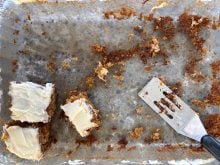It was two years ago, at Thanksgiving, that my dad passed away. As our family was gathering to celebrate Thanksgiving this year, Mom and Dad were on my mind.
In preparing our holiday table I unearthed one of my parents’ treasured possessions – a wedding gift of sliver plate casserole servers. By using them I am honouring their memories, traditions and values.
Cleaning tarnished silver
Arm and Hammer washing soda provides a solution for cleaning the dark black tarnish off silver. Place the silver on a piece of aluminum foil in a plastic tub or bucket. Dissolve 1/4 cup (60 mL) of washing soda in one gallon (four L) of hot water. Let the silver stand until the tarnish is gone. I only left the silver in the solution for a few minutes. I found that you need to change the aluminum foil when it loses its shiny appearance. Remove the pieces from the solution, then rinse, dry and polish.
Read Also

Producer profits remain under significant pressure
Manitoba farmers are facing down a double hit of high input costs, like fertilizer, and low grain prices as they harvest their next crop.
On the box there is a warning not to use this on “antiqued” or deliberately darkened silver or pieces with cemented handles. Rubber gloves are a must because the solution dries your hands.
After rinsing I used some liquid silver polish and finished the cleaning process. There were a few spots that needed that extra cleaning, but the tarnish came off easily, with little elbow grease.
I bought some silver cleaner that contains a tarnish preventive. The manufacturer recommends that you leave some of it on the clean silver for a few minutes and then polish it off. This will slow the tarnishing
action.
Sulfer-containing compounds in the air cause the silver to tarnish, so keeping it wrapped in anti-tarnish treated cloth bags or wrapping with clear plastic wrap or even storing in a tightly closed china cabinet will all help to slow the tarnishing process. Sterling or plate sliver will need less frequent polishing if you use and wash it often.
Smelly towels
Several readers have asked what to do with dish cloths, towels and face cloths that develop a sour smell.
The smell is caused by mould growth in the damp fabric. The solution is to wash with a product that will kill the mould and then dry and cool the towels well.
If the fabric and colours can be bleached, launder the cloths in hot water with one cup (250 mL) of chlorine bleach per machine load with detergent. Mix the bleach well with water before adding the towels. An alternative that is safe for most fabrics and colours is to dissolve 1/3 cup (75 mL) Arm & Hammer washing soda in hot water, along with your normal detergent. Again, mix well then add the towels and wash as normal.
The second step is to quickly dry the towels. Don’t allow them to sit in a washer for several hours or days because the mould will start to grow again. The best drying method is to hang them on a clothesline outdoors on a sunny day. The sun and wind will give them a fresh clean smell. The sun also tends to disinfect them. If drying in a clothes dryer, the towels should be thoroughly dried and then allowed to cool before folding and putting away. Again hang them on a line outside or over chairs or towel bars to cool and finish the drying.
Cabbage borscht recipe
Dear TEAM: A local restaurant serves a cabbage borscht that is really excellent. The chef will not share the recipe so I am hoping you can help me duplicate it. It is greeny gold in colour so I don’t think there are tomatoes, beets or meat involved. The consistency is creamy so there is probably whipping cream and the flavour is tart and fresh so it probably has vinegar and dill. He says it is a Doukhobor recipe and I have tried a couple but am not happy with the results. – N.O., Carstairs, Alta.
Dear N.O.: This recipe uses a mushroom broth. I hope it is close to what you are looking for.
1 pound fresh 500 g
mushrooms, sliced
1 large onion, chopped
1 sprig of fresh parsley,
chopped
2 tablespoons butter 30 mL
2 quarts hot water 2 L
3 cups cabbage, 750 mL
shredded
1 cup carrot, chopped 250 mL
1 teaspoon salt 5 mL
2 cups potatoes, cubed 500 mL
1 cup sour cream 250 mL
2 tablespoons fresh 30 mL
dill weed
salt and pepper, to taste
Clean and slice the mushrooms and onion. Melt the butter in a large pot, add the onion and chopped parsley and stir to cook. Add the mushrooms, cook and stir. Add hot water and bring to a boil; reduce heat and simmer at a low heat for 10 minutes. Pour cold water in to keep the same quantity of broth.
Add chopped carrot, shredded cabbage and salt. Bring to boil again. Then add the potatoes. When the vegetables are cooked, stir in the sour cream and dill and season to taste with salt and pepper. Serve with fresh bread or buns.
This recipe is adapted from a number of recipes from cuisine@russian foods.com.
Christmas cookbook draw
Our theme for this year’s Christmas cookbook draw is household hints. We would like to hear some of your favourite cleaning or home management hints. Send them in with your name and address to TEAM Resources Christmas cookbook draw. Send by mail to Box 2500, Saskatoon, Sask. S7K 2C4 or e-mail to team@producer.com. The draw will be held Dec. 7. Watch our future columns for which cookbooks we will be giving away.
Betty Ann Deobald is a home economist from Rosetown, Sask., and one of four columnists comprising Team Resources. Send correspondence in care of this newspaper, Box 2500, Saskatoon, Sask., S7K 2C4 or contact them at team@producer.com.
















